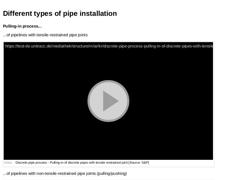
|

Pulling-in process... ...of pipelines with tensile-restrained pipe joints (Video: Discrete pipe process - Pulling-in of discrete pipes with tensile restrained joint) ...of pipelines with non-tensile-restrained pipe joints (pulling/pushing) (Video: Pulling-in of discrete pipes with non-tensile restrained joints) ...of discrete pipes (Video: Discrete pipe process - Pulling-in of single pipes into the section) Pushing-in process (Video: Pushing-in of discrete … |
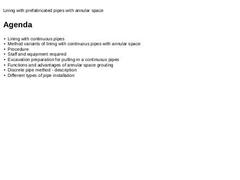
|

|

|

DIN EN 13566 / ATV-DVWK-M 143-11
Lining with close-fit pipes Lining with close-fit pipes:
Lining with a continuous pipe for which the cross-section is reduced to facilitate installation and reverted after installation to provide a close fit to the existing pipe [DINEN13566-1:2003]. | | (Image: Compact pipe process with reference to [FI-Wavin] - Pulling-in the C-shaped folded continuous pipe [Image: S&P GmbH])
|
|
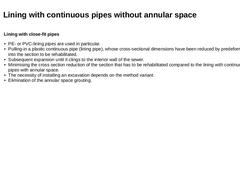
|

|

|

| (Image: Sequence diagram for renovation of drains and sewers with prefabricated pipes - Lining with continuous pipes without annular space)
|
|
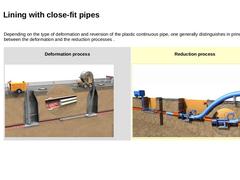
|

|
Depending on the type of deformation and reversion of the plastic continuous pipe, one generally distinguishes in principle between the deformation and the reduction processes . | Deformation process (Image: Compact pipe process with reference to [FI-Wavin] - Pulling-in the C-shaped folded continuous pipe [Image: S&P GmbH])
| Reduction process (Image: Reduction process with thermal-mechanical diameter reduction (Swagelining) with reference to [FI-Advan] - … |
|
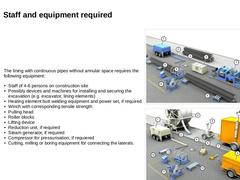
|

|
The lining with continuous pipes without annular space requires the following equipment: - Staff of 4-6 persons on construction site
- Possibly devices and machines for installing and securing the excavation (e.g. excavator, lining elements)
- Heating element butt welding equipment and power set, if required
- Winch with corresponding tensile strength
- Pulling head
- Roller blocks
- Lifting device
- Reduction unit, if required
- Steam generator, if required
- Compressor …
|
|
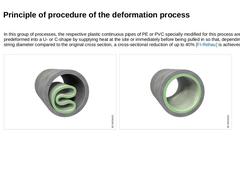
|

|
In this group of processes, the respective plastic continuous pipes of PE or PVC specially modified for this process are predeformed into a U- or C-shape by supplying heat at the site or immediately before being pulled in so that, depending on the string diameter compared to the original cross section, a cross-sectional reduction of up to 40% [FI-Rehau] is achieved. | |
(Image: Deformation process – lining pipe pre-deformed)
|
(Image: Deformation process - … |
|
|

|

|
In contrast to the deformation process, the outside diameter of the HD-PE plastics continuous pipe is thermally and/or mechanically reduced by about 10% immediately before the insertion process while the circular cross section is maintained, and it is expanded again until it clings to the inner wall of the sewerby using the material's own "memory effect". | Swage-Lining
Thermo-mechanical deformation of continuous pipe (Image: Reduction process with thermal-… |
|

|

| The temporary diameter reduction is thermally and mechanically carried out in a die. This basically consists of a firing chamber, a heating section and a die plate. | (Image: Reduction process with thermal-mechanical diameter reduction (Swagelining) with reference to [FI-Teerb] - View on the starting excavation [Image: S&P GmbH]) | | (Image: Reduction process with thermal-mechanical diameter reduction (Swagelining) with reference to [FI-Teerb] - View … |
|

|

| (Image: Reduction process with mechanical diameter reduction (Rolldown process) with reference to [FI-Klug] - Sketch of the principle [Image: S&P GmbH])
In the rolldown process, the temporary diameter reduction of the prefabricated continuous pipe is achieved mechanically with the aid of a hydraulically driven gripper mechanism and two - or for larger nominal sizes three - hemispherical roller pairs set at 90° to each other . | | (Image: Deformation … |
|

|

|

|

RIB-LOC-Relining-System (Image: Depiction of the lining with site manufactured pipes (spiral lining process) using the RIB-LOC-Relining-System as an example with reference to [FI-RIBLOb] - Sketch of principle [Image: S&P GmbH])
| SPR process (Image: Spiral lining process RotaLoc with reference to [FI-RIBLOa] [Image: S&P GmbH] - Sketch of principle)
|
|
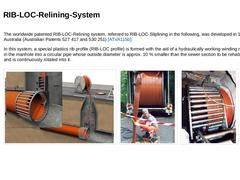
|

|
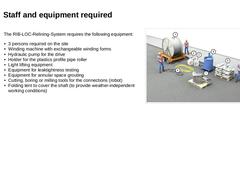
|

| (Image: Equipment for lining with site manufactured pipes with anular space)
The RIB-LOC-Relining-System requires the following equipment: - 3 persons required on the site
- Winding machine with exchangeable winding forms
- Hydraulic pump for the drive
- Holder for the plastics profile pipe roller
- Light lifting equipment
- Equipment for leaktightness testing
- Equipment for annular space grouting
- Cutting, boring or milling tools for the connections (robot)
…
|
|
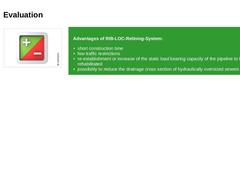
|

| (Image: Pros and cons) | Advantages of RIB-LOC-Relining-System: - short construction time
- few traffic restrictions
- re-establishment or increase of the static load bearing capacity of the pipeline to be rehabilitated
- possibility to reduce the drainage cross section of hydraulically oversized sewers
|
|
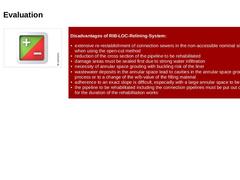
|

| (Image: Pros and cons) | Disadvantages of RIB-LOC-Relining-System: - extensive re-restablishment of connection sewers in the non-accessible nominal size area when using the open-cut method
- reduction of the cross section of the pipeline to be rehabilitated
- damage areas must be sealed first due to strong water infiltration
- necessity of annular space grouting with buckling risk of the liner
- wastewater deposits in the annular space lead to cavities in the …
|
|
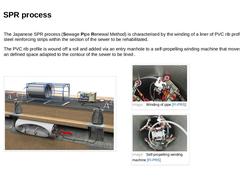
|

|
The Japanese SPR process (Sewage Pipe Renewal Method) is characterised by the winding of a liner of PVC rib profiles with steel reinforcing strips within the section of the sewer to be rehabilitated. The PVC rib profile is wound off a roll and added via an entry manhole to a self-propelling winding machine that moves along an defined space adapted to the contour of the sewer to be lined . | | (Image: Spiral lining process RotaLoc with reference to [FI-… |
|
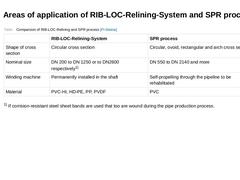
|

(Table: Comparsion of RIB-LOC-Relining and SPR process [FI-Steina]) |
|
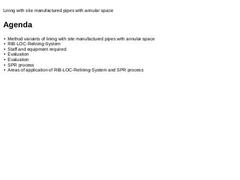
|

|

|

|
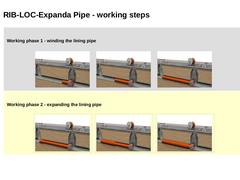
|

| Working phase 1 - winding the lining pipe |
(Image: RIB-LOC-Expanda Pipe - Working phase 1: Winding of the lining pipe from starting manhole to target manhole (working step 1))
|
(Image: RIB-LOC-Expanda Pipe - Working phase 1: Winding of the lining pipe from starting manhole to target manhole (working step 2))
|
(Image: RIB-LOC-Expanda Pipe - Working phase 1: Winding of the lining pipe from starting manhole to target manhole (working step 3))
|
| Working … |
|
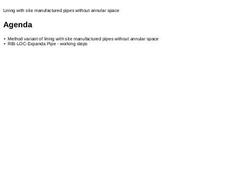
|

|
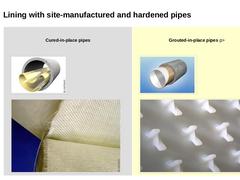
|

Cured-in-place pipes |
(Image: Lining with pipes)
|
|
(Image: Carrier material)
|
| Grouted-in-place pipes p> |
(Image: Grouted-in-place process - System variation of the TROLINING® process - Basic system with reference to [FI-Troli] [Image: S&P GmbH])
|
|
(Image: Stud hose - stud height 19 mm)
|
|
|

|

|